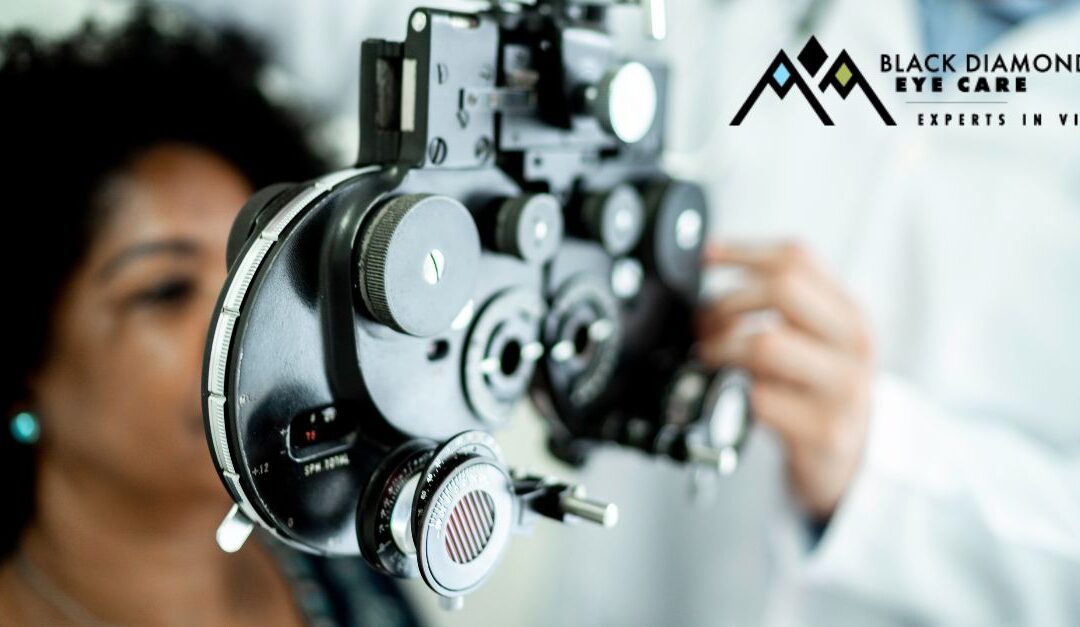Routine eye exams are very important for maintaining good eye health because it can help detect eye conditions and diseases much earlier. But for first-time patients, an eye exam can feel a little intimidating.
Knowing what to expect for your first optometry exam can be helpful. These exams are relatively straightforward, but a first-time appointment may be a bit more involved than routine exams. Here is what you can expect.
1 | What You’ll Need to Bring with You
As with any other kind of medical appointment, you’ll need to bring a picture ID, your vision insurance information, a form of payment, a complete list of medications, family history of eye diseases, and your current glasses (like readers). It is likely that your provider will want to go over your family history and risk factor for eye diseases with you during your exam.
2 | Visual Acuity Test
This is something you probably already know about and it simply measures how well you see with each eye. Your optometrist will ask you to close an eye and read letters on an eye chart or through a device called a phoropter. A phoropter has several lenses that can help you see better. This process is called refraction and tells your provider if you need glasses and helps find the right prescription for you.
For young children and people who have trouble communicating, an autorefractor can be used to measure visual acuity. This device shines light into the eye and measures the eye’s response to find the correct prescription.
3 | Visual Field
To check your peripheral (side) vision and tell about your full range of vision, your optometrist will hold up a finger or object and gradually move it from one side of your face to another, bring the object up and down, or bring it closer to your eyes. You’ll only move your eyes during this test, not your head. Some optometrists use a computer program to conduct this test.
4 | Color Vision Test
Your optometrist will check for color blindness by showing you a series of images with colored dots. Hidden in those dots are numbers in different colors. Those who have color blindness, or color deficiency, may not be able to see the numbers.
5 | Corneal Topography
This test uses a computer to create a “map” of your cornea. You simply look at an object while the computer takes thousands of measurements of your cornea. This can show curvature of the cornea (astigmatism) and is used to help fit you with contact lenses or prepare for corneal transplants or other eye surgeries.
6 | Ophthalmoscopy (Fundoscopy)
Your provider will use eye drops to dilate your pupils (makes them get bigger to let in more light and see in the back of your eyes easier). It takes about 15 to 20 minutes for your pupils to fully dilate after the drops are applied. Once open, your optometrist can examine the cornea, lens, retina, optic nerve, and surrounding blood vessels.
7 | Slit-Lamp Exam
This test also requires eye drops to dilate your pupils, but this time, your provider will examine your eyes using a microscope (slit-lamp). This is mounted to a table and you rest your chin and forehead on the equipment. Then the provider will look at your eyes through the device, allowing them to see the parts of your eyes under high magnification.
8 | Tonometry
This test detects issues with eye pressure. Increased pressure is a sign of glaucoma. Drops will be placed into your eye to numb the area. Then an instrument called a tonometer blows a small puff of air on the cornea. During applanation tonometry, your provider uses a flat-tipped cone that gently comes into contact with your cornea, which measures the amount of pressure needed to flatten a portion of your cornea.
9 | Fundus Photography and Optical Coherence Tomography (OCT)
These imaging tests are used to evaluate the structures in the eye, such as the retina and optic nerve. Sometimes the pupil is dilated first. Then a camera or imaging scanning system is used to obtain digital images. These can be used to diagnose or follow the progression of various retinal, optic nerve, and corneal conditions.
10 | Prescription Lenses or Contacts
If you need corrective lenses, your provider will then guide you through the process of selecting the right options for you, such as hard versus soft contact lenses and different types of lenses for glasses.
Final Takeaways
During your first eye exam, your provider may or may not do all of these different tests. It depends on any concerns you’ve expressed while scheduling your appointment or that have been passed on in a referral from your general practitioner. You may expect some of these tests in a follow up appointment, and depending on your risk factors, you may do some of these tests more often than other patients. Remember, that it is okay to ask questions of your provider prior to an exam to help better understand what to expect during your appointment!
Ready to schedule your first eye exam? Black Diamond is your expert in vision! We offer comprehensive eye care services for you and your family, including routine exams, contact lens fitting, and treatment for eye conditions. Schedule your appointment online today!




